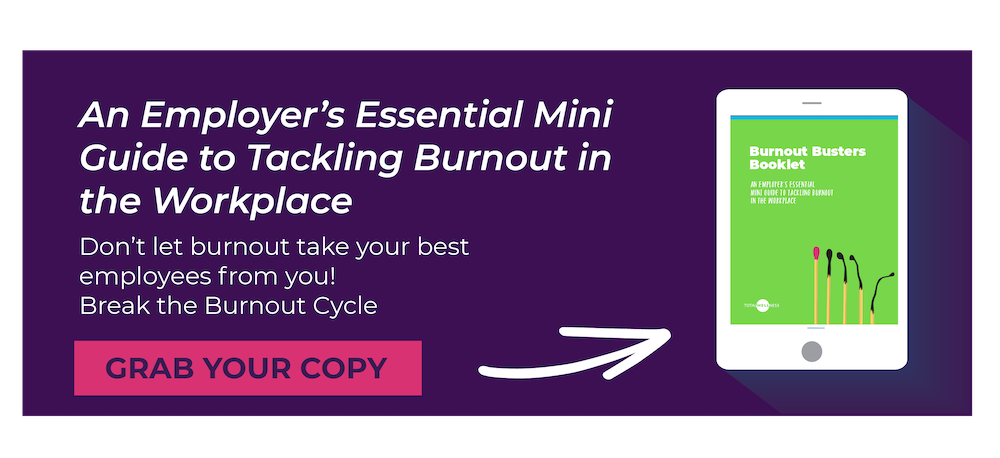People who have never experienced anxiety before were introduced to it in a forceful way during the  pandemic that started back in 2020. The virus and its trickle effect caused increased stress for many who were forced to isolate and changed the way they connected with others.
pandemic that started back in 2020. The virus and its trickle effect caused increased stress for many who were forced to isolate and changed the way they connected with others.
As the pandemic evolved and stretched on, the impact on mental health became quite clear —the World Health Organization reported a 25% increase globally in anxiety and depression. The lack of socializing impacted everyone from children to avid business travelers and everyone in-between.
Now, in the post-pandemic world, social anxiety, depression, and even OCD symptoms may be impacting your workers more than you know when it comes to re-entry back into the workplace. As the virus evolves and continues to infect people — even the vaccinated — again and again, these issues of mental health can’t be ignored.
Here’s a look at how post-pandemic anxiety could be impacting your workers as they make their way back into the workplace on a more permanent basis.
What is Post-Pandemic Anxiety?
For some people, the idea of going in public or even going maskless is enough to evoke major anxiety, especially after a few years of being told to stay away from people outside your household by numerous health officials.
As a result, “COVID-19 anxiety syndrome” — or post-pandemic anxiety — is becoming an issue for those returning back to workplaces and/or a semi-normal life. This includes compulsive symptom checking and avoiding leaving the house, even if health risks are minimal. It also may include an aspect of social anxiety, which in turn can further lead to isolation and loneliness for individuals dealing with it.
Not surprisingly, the pandemic had a major impact on mental health. Statistics recorded by the Centers for Disease Control and Prevention (CDC) between June 24–30, 2020 indicated an estimated 40% of American adults reported at least one mental health concern, including anxiety, depression, substance use, and suicidal ideation.
For those experiencing overwhelm and anxiety upon being back in the workplace, experts say it’s important to take notice of that.
RELATED: 5 Myths About Anxiety Your Anxious Employees Want You to Know
Who May Be Experiencing COVID-19 Anxiety Syndrome
For those who struggled with social anxiety prior to the pandemic, returning to the workplace — and other public settings — may be even more challenging. That’s because with lockdowns and restrictions, going out and interacting with others was required a lot less. The anxiety never fully went away, it just wasn’t engaged as much.
This is especially true in areas that have bounced back and forth between mask mandates, lockdowns, and other public health announcements that come across as mixed messaging. It gave anxious thinkers more time to worry and feel uncertainty. Additionally, those with conditions like OCD may find that their stress is amplified with a return to the workplace, according to Medical News Today.
Low tolerance for uncertainty and ongoing media coverage can also contribute to anxiety surrounding COVID-19 and returning back to normal operations.
The Effects of Anxiety on the Workplace
Fear and anxiety about the virus have been an ongoing issue throughout the pandemic. Given the initial high death toll and rapid spread, many unknowns about the virus caused a lot of fear for individuals.
A Frontiers in Public Health study published in October 2021 found of nearly 30,000 people analyzed, over 50 percent were concerned about being infected by COVID at work. That type of anxiety can lead to absenteeism and lowered productivity. The report added that it’s clear the ''work environment, organization, and work-related behaviors can affect the mental health and psychological well-being of workers.”
The gatherings can be particularly jarring if not eased into. For some workers, this may mean not going to after-work gatherings, staying around to chit-chat, and other social situations, which can change workplace culture and dynamics.
Tips for Employees Trying to Manage Post-Pandemic Anxieties
Luckily, just like with regular anxiety, there is hope for managing post-pandemic anxiety in a helpful way. Here are a few tips to post in your workplace or share via email:
- Acknowledge it - No one likes to feel tension, discomfort, or anxiety. Sit with the feeling and acknowledge that it’s there. In doing so, you don’t push it away to deal with later. You face it straight on, which can help you confidently manage anxious thoughts.
- Revisit the worry - Once you face the worry, concern, or anxiety, come back to it. What happened? Did it turn out as bad or worrisome as you initially thought? Fact-check the situation and if it didn’t turn into your worst-case scenario, there’s anxiety relief that comes with that.
- Take baby steps - Now that the virus spread has slowed and a vaccine is available, social gatherings are becoming a regular occurrence again. If you’re struggling to enjoy the activities you did once before the pandemic, start small. Go out to coffee with a friend; join happy hour with colleagues for a bit; attend an outdoor concert; host a BBQ. It will help you get acclimated to socializing and can lessen your anxiety once you get back into it.
- See a mental health professional - If you’re feeling stuck in an anxious loop, it may be time to intervene with the help of a licensed mental health professional. Examples of getting stuck may include: Obsessively washing your hands or even excessive cleaning like wiping down work surfaces numerous times an hour, sanitizing your hands, etc.
Helping Your Team Readjust to Life at Work
There’s no doubt about it, the pandemic has changed the way we all work. Helping your in-house workers find that happy medium again can make it a better experience and alleviate some of their anxieties.
Some ways to alleviate workers’ anxieties:
- Everyone is different - As workers settle back into the workplace, just remember everyone has a different threshold for anxiety. Those who experience anxiety are dealing with a “perceived threat” that can alter a person’s perception daily. What may bother one person won’t be of concern to another. Keeping that in mind can make the transitions to come back together as a team a little easier.
- Plan some outdoor events - Get your team socializing again with some fun outdoor events, especially if they’ve been wary to do so. Assure them that their safety is important. Fresh air is constantly circulating, which makes it more difficult to catch the virus outside. Have hand sanitizer around as well for workers to use between activities.
- Meditate together - Penn State Medicine talks about deep breathing as a coping mechanism for anxiety. Naturally, anxiety takes someone’s breath away. Consider hosting a yoga or meditation class in an outdoor area near your business. Breathwork can be extremely valuable to your employees and help them learn how to focus on mindfulness in times of stress.
- Share valuable resources - Some employees may be experiencing anxiety for the first time ever. Help them work through it by offering resources to better understand and manage it. Stress management resources can be invaluable to your workers’ mental health and overall well-being. The Anxiety & Depression Association of America also has plenty of resources to share with your team, too.
- Understand that shaking hands may still be taboo - Since the virus is able to spread from person to person and handshaking was essentially all but banned during the pandemic, understand that some workers may not be comfortable shaking hands again, or ever. Respect that and let them shake hands again on their own terms.
- Talk openly - The post-pandemic era and the potential recession may also be impacting your employees’ stress levels and anxiety. Be honest and open about the work situation. Communication on a regular basis can help alleviate worries.
- Be empathetic - For those who have never experienced anxiety, it can be hard to relate and almost feel trivial why an individual gets worked up over activities like in-person meetings or coming to work. The pandemic changed the world and people’s ways of living in it. Do your best to be patient and hear where your workers are coming from when they express concerns. Doing so displays you care about your workforce.
Ongoing workplace stress — even in the post-pandemic era — can lead to burnout, so watching employees for signs of excessive worry, stress, and overwork and making changes as needed will certainly lead to better outcomes for all.



